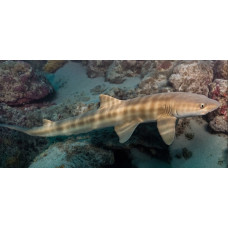Latin name
Chiloscyllium griseum
Other name
Chiloscyllium griseum
Identification
The grey bamboo shark has a slender cylindrical body with no lateral or dorsal projections. The head has no lateral skin folds. The snout is conical and rounded. The eyes are dorsolateral. The length of the eyes is 1.3-2.2% of the length of the body. There are spiracles behind the eyes. The gill slits are small, the fifth and fourth are close together. The nostrils are framed by antennae. The outer edge of the nostrils is surrounded by folds and grooves. The small, almost transverse mouth is located in front of the eyes and shifted to the tip of the snout. The folds of the lower lip are connected to the chin by skin folds. The lower and upper teeth are not clearly differentiated, having a central point and several lateral denticles. The distance from the tip of the snout to the pectoral fins is 16.5-19.5% of body length. The total number of vertebrae is 156-170. The number of coils of the gutter varies from 15 to 19.
Features of fish fins
The pectoral and pelvic fins of these sharks are small, broad and rounded. The dorsal fins are of equal size. They are strongly displaced posteriorly. There are no spines at their bases. The distance between their bases is small, slightly more than the length of the base of the first dorsal fin and equal to 8.7-11.5% of the body length. The base of the first dorsal fin is posterior to the base of the pelvic fins. The height of the first and second dorsal fins is 6.2-8.2% and 7.4-9.1% of the body length respectively. The base of the long, low, keel-shaped anal fin is posterior to the base of the second dorsal fin. The distance from the tip of the snout to the anal opening is 34.5-38.3% of body length. The distance from the anal opening to the tip of the caudal fin is 58.1-64.4% of body length. The length of the base of the anal fin is 6 times its height. The caudal fin is asymmetrical, the upper lobe is not elevated above the apex of the body and has a ventral notch on its edge. The lower lobe is not developed. Lateral carinae and precaudal fossa on the caudal peduncle are absent.
Fish colouring
The grey bamboo shark is a flat yellow-brown colour with faint bright spots on the fin tips of juveniles. Juveniles have dark brown stripes on the body and head, while adults are uniformly grey or light brown. The stripes on juveniles help them camouflage themselves and hide from predators and larger sharks in the narrow crevices of coral reefs.
Distribution
The grey bamboo shark is found in the northern part of the Indian Ocean, including the Persian Gulf, and the western part of the Pacific Ocean. It has been recorded in the waters of Pakistan, India, Sri Lanka, Malaysia, Thailand, Indonesia, China, Japan, the Philippines and Papua New Guinea.
Habitat
They are coastal bottom sharks that live at depths between 5 and 80 metres.
Size
Sharks of this species can reach up to 0.75 metres in length.
Behavior
Grey bamboo sharks do not form schools and are usually solitary. They are therefore rarely seen.
Food and feeding habits
These sharks feed mainly on small fish and benthic invertebrates.
Reproduction
Grey bamboo sharks reproduce by laying eggs. Both sexes form a distinct pair. Males reach sexual maturity at a length of 45-55 cm.
Fishing
Of little interest to commercial fisheries. They are caught and used as food in Pakistan, India and Thailand.
Relationship with a person
This shark is not dangerous but may bite if disturbed. The grey bamboo shark can be kept in aquariums.
| Classification | |
| Phylum | Chordata |
| Class | Chondrichthyes |
| Squad | Orectolobiformes |
| Family | Hemiscylliidae |
| Genus | Chiloscyllium |
| Species | C. griseum |
| Features | |
| Conservation status | Vulnerable |
| Habitat | Bottom |
| Life span, years | No information |
| Maximum body weight, kg | No information |
| Maximum length, cm | 75 |
| Sailing speed, m/s | No information |
| Threat to people | Edible |
| Way of eating | Predator |
Grey bamboo shark
Tags: grey bamboo shark

